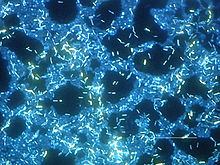The hospital germ Pseudomonas aeruginosa can cause serious wound as well as lung and urinary tract infections, especially in weakened individuals. Pseudomonas manages time and again to survive attacks of the immune system and antibiotic therapies. One key to the success of this persistent pathogen is its complex communication system as the bacteria use various signalling substances to communicate with each other and to control infection processes. Scientists from the Helmholtz Centre for Infection Research (HZI) in Braunschweig and the Helmholtz Institute for Pharmaceutical Research Saarland (HIPS) in Saarbrücken recently discovered how these bacteria produce a large part of the variety of signalling molecules: The ability of a single protein complex to change its shape allows the bacteria to process molecules of different sizes into signalling substances. If it is possible to develop an inhibitor for this complex, one could “freeze” its motion and interrupt the communication of the bacteria.
The pathogen Pseudomonas aeruginosa (P. aeruginosa) uses a variety of tricks to perfectly adapt to its environment. Pseudomonas bacteria can colonise and proliferate in virtually any environment, including the lungs, eyes, urinary tract, an open wound or an implant. They even manage to survive most antibiotics by shielding themselves in a dense biofilm or by simply pumping the toxins from their interior with the help of small pumps. The bacteria communicate with each other when they select the effective survival strategies to be used. For this purpose, they release a variety of signalling molecules, which trigger the respective reaction of the bacteria when a certain threshold (“quorum”) is exceeded. This type of communication is called “quorum sensing” – and as if this wasn’t enough, P. aeruginosa possesses no less than three different interconnected systems for this purpose.
The bacteria’s adaptability makes the treatment of P. aeruginosa particularly difficult. For this reason, scientists throughout the world are searching for properties that are specific to these bacteria and can be used as points of attack of novel medications. One very promising target is one of the communication systems – the so-called pqs system (Pseudomonas quinolone signal), which is present as such only in P. aeruginosa. It has been known for a long time that this system works with a broad range of signalling molecules, but it was not known in detail how the diversity of these molecules arises. “We’ve known for a number of years that a complex made up of proteins called PqsB and PqsC is responsible for the diversity of signals of Pseudomonas aeruginosa,” says Prof Wulf Blankenfeldt, who is the head of the “Structure and Function of Proteins” department at the HZI. “Here, PqsB serves as a stabiliser, whereas PqsC carries out the chemical reaction: It produces molecules that have similar structures, but differ in the length of their fatty acids chains, although the exact molecular details of this were previously unknown.”….







